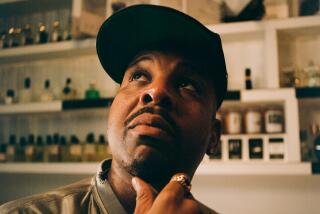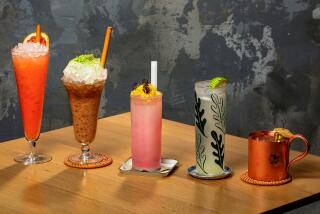A new frenzy for fine Scotch
You may think you know single-malt Scotch -- it’s Glenlivet and Macallan and Laphroaig and all that. Maybe you’re even into some obscure ones: Dalwhinnie, Edradour, Allt-a-Bhainne, Bruichladdich.
What makes them single malts is that they’re unblended whiskies, products of single distilleries. But if all you know are the versions bottled by the distilleries themselves, you know only part of the story. There’s an alternate universe of Scotch: the independent bottlers. They sell whisky from the same distillers, but in limited editions that have distinctive flavors of their own.
As it happens, the largest selection of single-malt Scotches in the country is here in Southern California -- in an obscure corner of Van Nuys. Wine and Liquor Depot has two long aisles of single malts, a dizzying panorama of 600 or more bottlings, and more than two-thirds of them bottled by independents.
Though a number of bottles are in the $30 to $40 price range, many are more than $100 and the rarest are very pricey. “The other day a guy came in and bought up all my Gordon & MacPhail Glen Grants, from here to here,” says Wine and Liquor Depot owner Howard Meister, indicating about 16 inches of shelf space. “It was a $4,500 sale.”
Only perhaps 10% of all single malt is bottled as single malt in the first place; the rest is sold off to flavor blended Scotch. And the independent bottlers handle only a fraction of that percentage. But it’s the fraction that excites Scotch fanatics.
“There’s such variety,” says single-malt enthusiast Martin Kari of Thousand Oaks. “The independents are iconoclasts. They aren’t trying to maintain a standard flavor profile. They can give you a completely different impression of the character of the whisky.”
Scotch reflects its physical origins much as wine does. Los Angeles lawyer David Kenney, who has compiled a voluminous tasting book listing every malt he’s learned of, most of them independent bottlings, recalls the first time he let a really old single malt linger in his mouth: “I could taste everything that went into it. I could taste the peat, the stones, the air -- I had this vision of a stag running through the highlands; the sense of rain, fog, years.”
But even when an independent bottling and an “official” bottling are the same age, one may highlight a honeyed, grassy quality while the other puts forward the bracing herbal flavor of the water the distillery uses, or the smokiness of its roasted barley, or the saltwater tang of the air, if the distillery is near the sea, or even more mysterious flavors.
*
A taste all their own
Why do the independent bottlings taste different from the distilleries’ own bottlings? The independents can choose to age the whisky their own way. Some buy casks (all Scotches are aged in oak, usually used Sherry casks) as soon as the distillery fills them and age them in their own warehouses. Others let the casks stay at the distillery to mellow, but perhaps for a longer time than the rest of the distillery’s output. And some bottlers specialize in bottling rare old casks, of which a surprising number show up here and there.
Another difference is that most independents omit the usual step of “chill filtering,” in which whisky is refrigerated to near freezing to remove elements that would make the whisky cloudy if you put ice in your drink. Unfortunately, these elements have flavors of their own. Also, many independents bottle straight from the cask, at proofs up to 130, rather than adding water to reduce the alcohol level to the standard 80 or 86 proof.
But what makes the independents unique is that they bottle from single casks, rather than blending several casks to maintain a consistent house style, the way distilleries do. As a result, they bring out specific aspects of the whisky in each particular cask. There can be real surprises. “Every once in a while,” says Kari, “even what we generally consider a bland distillery can produce a single cask that is outrageously good.”
In the 19th century, when single malt was the only kind of Scotch there was, distillers did not bottle their whisky (even today, very few distilleries have their own bottling facilities). They sold casks to markets or liquor stores in Scotland, which aged and bottled the whisky as they saw fit. These were the original independent bottlers.
Later in the century, blended Scotch was invented for the tastes of the English public, which wasn’t up to the robust flavor of single malt. By the 1920s, it had taken the form we know today: blended with bland grain whisky, chill-filtered, colored brown with caramel (Scotch is naturally straw yellow), reduced to 80 proof and given a brand name such as Johnny Walker or Cutty Sark.
In the years following World War II, blended Scotch conquered the world. Nearly all single malt was bought by the blenders. Even in Scotland, most independent single-malt bottlers had gone out of business by 1950.
But in the 1960s, one of the survivors, Gordon & MacPhail, tried marketing single malts outside Scotland. Americans became familiar with names such as Glenfiddich, Glenlivet and Talisker, and other distillers started thinking about getting part of their output bottled under their own names.
Then in 1968, Gordon & MacPhail took a chance on bottling a Scotch at cask strength, rather than diluted to standard proof. That was probably when the modern single-malt craze began.
*
Rise of the independents
Today there are about two dozen independent bottlers, not counting firms that specialize in, say, the Dutch, Japanese or Scandinavian market. A few have decided tastes. Hart Bros. is known for preferring less peaty Scotches. Vintage Malt Whisky Co.’s Coopers Choice line is always aged in used Bourbon barrels, rather than in the more common Sherry barrels.
Vintage Malt is one of the bottlers that follows the old tradition of bottling certain famous Scotches under a marketing agreement that does not allow them to mention the distillers’ names. Scotch fans are pretty sure of most of the secret identities. For instance, there’s no doubt that Vintage Malt’s “Classic of Islay” is really Lagavulin, one of the peatiest, most mouth-filling of Scotches.
Cadenhead Ltd. and Gordon & MacPhail are known for holding immense stocks of Scotch, which they buy young from the distillers and age in their own warehouses. Tomatin, the largest malt distillery in Scotland, flavors many a blended Scotch, but Cadenhead’s 13-year-old bottling of Tomatin (at 120.8 proof) shows a whisky that can stand on its own: It’s elegant and sweet, with a long finish. (In recent years, Cadenhead has stopped shipping to the U.S., so Cadenhead supplies are becoming rare.) Signatory is a newer company that also has a wide range of Scotches.
Murray McDavid Ltd. systematically refuses to filter or color, but it does blend casks when it can and dilutes all its Scotches to 92 proof. McDavid’s bottlings of the legendarily smoky Laphroaig are typically cleaner and more vivid than the distillery’s own. One of the most distinctive Scotches I’ve tasted was McDavid’s 17-year-old Royal Brackla, which had an elusive fruity-flowery aroma that brought to mind green wood, dried peaches and apricot pits. With the addition of a little water, it opened into a lovely smoky flavor.
McDavid’s opposite might be Blackadder Ltd., which specializes in what it calls raw cask: whisky bottled straight from a single cask with nothing removed but the splinters, presumably. Blackadder actively seeks out old casks -- its website includes a big note reading “We Buy Casks.”
That’s exactly the idea that built Duncan Taylor & Co. Its story actually begins in the United States with a man named Abe Rosenberg, who was the importer of the famous blended Scotch brand J&B.; Rosenberg was a fancier of single malt, though, and in the early 1960s he started buying casks and leaving them to age in Scotland. When he died in 1994, his estate found there were about 4,000 of them. They are being marketed by Duncan Taylor, which also sells Whisky Galore, a line of younger Scotches under 20 years old.
A lot of smaller Scotch distilleries went out of business during the 20th century. So all this interest in single malts should bring them back, right?
Maybe. It has created the demand -- but it has also raised the bar. “A number of small distilleries are considering reopening,” says Meister, of Wine and Liquor Depot. “But it’s tough for them. There’s no longer any market for a single malt that’s only 3 or 5 years old.” Start-up is the killer in the whisky business, because aging ties up your capital for so long. That was always the niche of the independent bottlers -- distillers were glad to sell off a cask or two for ready cash.
As independent bottlings have become more available to Scotch fanciers, a new rivalry has appeared between the distillers and the bottlers. Some distillers have begun releasing independent-style bottlings, unfiltered and cask-strength.
And relationships can get testy. A few years ago, Allied-Domecq, the giant liquor firm that owns Laphroaig Distillery, sued Murray McDavid to keep it from selling its Laphroaig with the Laphroaig name on the label. McDavid responded by labeling it “Leapfrog” and issuing a challenge, right there on the label: “What are you afraid of, Allied?” McDavid’s “Leapfrog” bottling is now a collector’s item.
It’s a sign of the times. A growing number of Scotch fanciers will prefer something called “Leapfrog” over a Laphroaig under the distillery’s own label -- because they consider it more authentic. The independent bottlers are making their mark.
*
(BEGIN TEXT OF INFOBOX)
How they compare
We wondered what it would be like to taste an “official” bottling of a particular single malt side by side with several independents’ versions, all of equal age.
The Times tasting panel -- including staff writer Emily Green, Food editor Leslie Brenner and deputy features editor Michalene Busico -- compared a distillery-bottled 12-year-old Macallan with three independent bottlings, tasting them in the accepted fashion. (Inspect the color, “nose” the aroma, then swirl and nose again. Taste. Then add a splash of water and repeat -- some aromatic elements are alcohol-soluble, so diluting the alcohol makes them pop out.)
The differences were striking. The distillery’s own bottling is a benchmark of great Scotch -- the “gold standard,” as one taster put it. But the independents revealed aspects of the whisky that are subdued in the “official” version. Signatory, at 86 proof like Macallan’s own, was exceedingly elegant, with aromas that emphasized herbs over the grass and caramel of the “official” bottling. The finish was smoother than the distillery’s bottling; it was also a paler caramel color (most of the distilleries add caramel color; most independents do not). Duncan Taylor’s 92 proof, deep straw colored Whisky Galore, was light and graceful, with a Champagne elegance and a distinct touch of apples reminiscent of Calvados. Adelphi, on the other hand, at 109.8 proof and with a paler straw color, had appealing leather and caramel notes; undiluted, it was quite rugged. With a splash of water, it became authoritative: Lovely grassy and peaty aromas emerged, and it became sweet and very smooth, with a long finish.
By the way, some people are surprised to learn that you should add a little water to fine whisky. Does that mean you can add ice too? Aye, the Scots say -- if you want to ruin it.
-- Charles Perry
--
Proof of individual tastes
These independent bottlings of single-malt Scotches are a very small sampling scooped from a very large pond. Still, we were surprised by the dramatic differences among them, and we could see why some people become obsessed with tasting as many as they can. All may be purchased at Wine and Liquor Depot, 16938 Saticoy St., Van Nuys, (818) 996-1414.
“Classic of Islay” (Lagavulin), 12 years old, Vintage Malt Whisky Co., $44.95
Extremely distinctive, with a powerful, smoky nose of peat and iodine; rounded, mouth-filling and dry on the palate, with a long finish. 92 proof.
“Leapfrog” (Laphroaig), 12 years old, Murray McDavid Ltd., $71.95
Clean and fresh-tasting, with a nose redolent of peat and iodine -- not unlike Laphroaig’s neighbor (and rival) Lagavulin. 92 proof.
The Macallan, 12 years old, Signatory, $45.95
Fine and elegant, with a smooth finish. 86 proof.
The Macallan, 12 years old, Whisky Galore (Duncan Taylor), $47.95.
A Champagne-like whisky with pretty grass notes. 92 proof.
The Macallan, 12 years old, Adelphi, $78.95
Serious, authoritative, somewhat peaty and very smooth, with a long finish. 109.8 proof.
Royal Brackla, 17 years old, Murray McDavid, $69.95
Smooth, rich and appealingly dry, with a very distinctive, vaguely vegetal nose -- dried peaches crossed with green wood? A little water opens it up and brings out a smoky aroma. 92 proof.
Tomatin, 13 years old, William Cadenhead, $79.95.
A classic, big-shouldered Scotch, rich and sweet, with lovely fruit quality and a woody, faintly gingery nose. A splash of water turns up the elegance. 120.8 proof.
-- Charles Perry
More to Read
Eat your way across L.A.
Get our weekly Tasting Notes newsletter for reviews, news and more.
You may occasionally receive promotional content from the Los Angeles Times.










